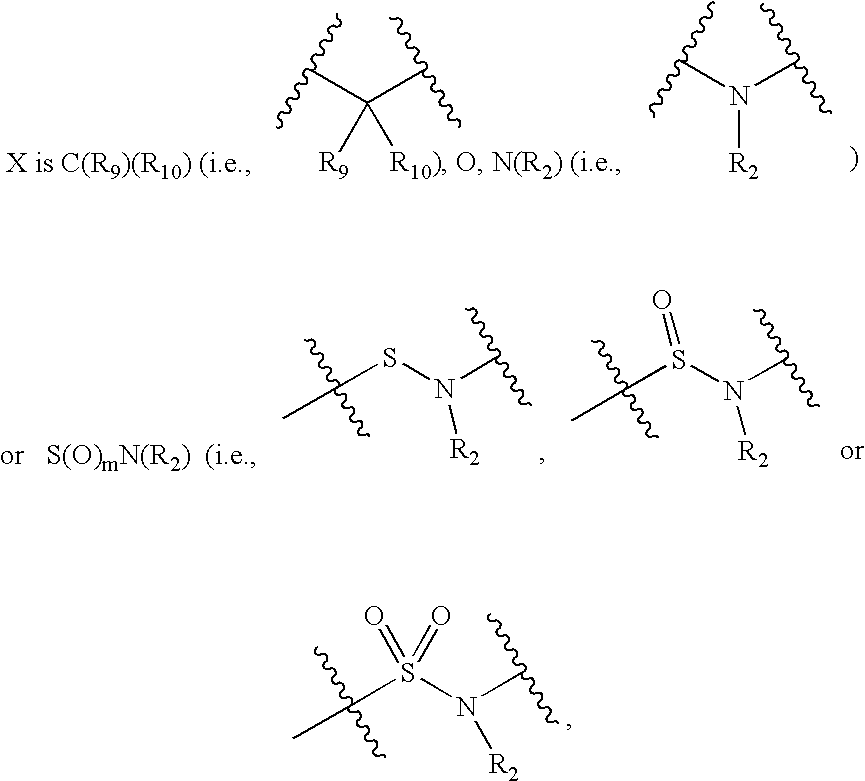Substituted heteroaryl CB1 antagonists
a technology of heteroaryl compounds and antagonists, applied in the direction of antibacterial agents, drug compositions, metabolic disorders, etc., can solve the problems of increased likelihood, limited efficacy of treatment programs focusing on behavior modification, and harmful and costly effects
- Summary
- Abstract
- Description
- Claims
- Application Information
AI Technical Summary
Problems solved by technology
Method used
Image
Examples
example 1
SYNTHESIS OF 1-[5-(4-CHLOROPHENYL)-6-(2-CHLOROPHENYL)-PYRAZIN-2-YL]-4-ETHYLAMINO-PIPERIDINE-4-CARBOXYLIC ACID AMIDE
STEP 1. 1-(6-CHLORO-PYRAZIN-2-YL)-4-ETHYLAMINO-PIPERIDINE-4-CARBOXYLIC ACID AMIDE
[0440]
[0441] A mixture of 2,6-dichloro-pyrazine (3.3 g, 22 mmol), 4-ethylamino-piperidine-4-carboxylic acid amide (3.85 g, 22.5 mmol) and K2CO3 (3.7 g, 26 mmol)- in CH3CN (30 mL) is heated at 100° C. for 1 h. The reaction mixture is cooled and evaporated under reduced pressure. The residue is mixed with water and filtered to collect a white solid. 1H NMR (CDCl3): 7.99 (s, 1H), 7.78 (s, 1H), 7.08 (br, 1H), 5.37 (br, 1H), 3.91 (m, 2H), 3.46 (m, 2H), 2.56 (q, 2H), 2.17 (m, 2H), 1.70 (m, 2H), 1.12 (t, 3H).
STEP 2. 1-(5-BROMO-6-CHLORO-PYRAZIN-2-YL)-4-ETHYLAMINO-PIPERIDINE-4-CARBOXYLIC ACID AMIDE
[0442]
[0443] A mixture of 1-(6-chloro-pyrazin-2-yl)-4-ethylamino-piperidine-4-carboxylic acid amide (449 mg, 1.58 mmol) and NBS (300 mg, 1.68 mmol) in CHCl3 (5 mL) is stirred at rt overnight. The react...
example 2
SYNTHESIS OF 1-[5-(4-CHLOROPHENYL)-6-(2,4-DICHLOROPHENYL)-PYRAZIN-2-YL-4-ETHYLAMINO-PIPERIDINE-4-CARBOXYLIC ACID AMIDE
[0446]
[0447] This compound is prepared as described in Example 1. LC-MS: m / z expected 504.8; found 505.0 (MH+).
example 3
SYNTHESIS OF 1-[5-(4-CHLOROPHENYL)-6-(2,4-DICHLOROPHENYL)-3-(METHYLAMINO)-PYRAZIN-2-YL]-4-ETHYLAMINO-PIPERIDINE-4-CARBOXAMIDE
STEP 1.1-[3-BROMO-5-(4-CHLOROPHENYL)-6-(2,4-DICHLOROPHENYL)-PYRAZIN-2-YL]-4-ETHYLAMINO-PIPERIDINE-4-CARBOXYLIC ACID AMIDE
[0448]
[0449] A mixture of 1-[5-(4-chlorophenyl)-6-(2,4-dichlorophenyl)-pyrazin-2-yl]-4-ethylamino-piperidine-4-carboxylic acid amide (20 mg, 0.04 mmol) and NBS (11 mg, 0.06 mmol) in CHCl3 (1 mL) is stirred at rt for 3 h. The reaction mixture is diluted with CH2Cl2 (1 mL), washed with aqueous Na2CO3 and water, and concentrated to give the title compound, which is used in the next step without further purification.
STEP 2. 1-[5-(4-CHLOROPHENYL)-6-(2,4-DICHLOROPHENYL)-3-METHYLAMINO-PYRAZIN-2-YL]-4-ETHYLAMINO-PIPERIDINE-4-CARBOXYLIC ACID AMIDE
[0450]
[0451] A mixture of the product from Step 1 and methylamine (4M in NMP, 1 mL) in a sealed tube is heated at 130° C. overnight. The mixture is diluted with CH2Cl2, and washed with water (5 times) an...
PUM
 Login to View More
Login to View More Abstract
Description
Claims
Application Information
 Login to View More
Login to View More - R&D
- Intellectual Property
- Life Sciences
- Materials
- Tech Scout
- Unparalleled Data Quality
- Higher Quality Content
- 60% Fewer Hallucinations
Browse by: Latest US Patents, China's latest patents, Technical Efficacy Thesaurus, Application Domain, Technology Topic, Popular Technical Reports.
© 2025 PatSnap. All rights reserved.Legal|Privacy policy|Modern Slavery Act Transparency Statement|Sitemap|About US| Contact US: help@patsnap.com



